Planting Material
 SUCKERS
SUCKERS
 SEED
SEED
 MICRO-PROPAGATED PLANTS
MICRO-PROPAGATED PLANTS
 MACRO-PROPAGED PLANTS
MACRO-PROPAGED PLANTS
Suckers
In India, use of conventional suckers cannot be completely avoided because of some regional special varieties tissue culture technique is yet to be perfected. further for resource poor small scale growers the cost of tissue culture plants stills a hurdle in adoption. there are three types of planting material used for propagation namely, Suckers, Peepers,Rhizome.
-
Natural regeneration of cultivated bananas through suckers is very slow due to hormone-mediated apical dominance of the mother plant.
-
A plant produces only 5-20 suckers during its life time of 12-14 months. For accelerating the propagation rate, suckers with growing buds or cut rhizomes called ‘bits’ and peepers’ are used.
-
Several good bits, each with a centrally placed germinating eye can be cut from an unbunched rhizome after trimming the roots.
-
Selection of appropriate mother plant for raising new propagules either through in vivo or in vitro methods is important.
-
About one kilogram uniformly sized rhizomes or bits, well-trimmed around the growing sprout are the best starting material.
-
In some parts of India rhizomes are sun dried for 2-3 days after paring and pralinage treatment (trimmed of all roots, dipped in mud slurry and sprinkled with nematicide) and stored in shade for a week before planting.
Selection of mother plants
-
Mother plant should be healthy, true to type and free from diseases and pests,especially virus diseases.
-
The male flowers buds should be retained to check the presence of virusdiseases (male flower buds exhibit symptoms of late infection of viruses like BBTV and BBrMV).
-
Mother plants should be raised under roofless insect proof shade net withsufficient height.
-
Mother nursery must be located away from other banana plantations with an isolation distance of 500 m to maintain purity and to avoid spread of virus diseases.
-
Mother plants should be grown under very good management conditions so as to facilitate the true expression of traits.
-
Individual plants should be tagged with a master code number so that the plantlets developed could be traced back to the mother plant.
-
Pedigree record and source of each mother plant should be maintained and catalogued.
-
Once indexed, the mother suckers can be maintained in field or concrete rings with frequent decapitation to facilitate production of more auxiliary buds. They also serve as explants for culture initiation.
Suckers
a) Sword Sucker
A sucker next to but only superficially attach to the mother rhizome with broad leaves at an early stage. Water suckers produce inferior fruit (not healthy banana clump) and are therefore not recommended. |
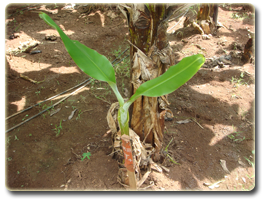 |
b) Water sucker
A sucker next to but only superficially attach to the mother rhizome with broad leaves at an early stage. Water suckers produce inferior fruit (not healthy banana clump) and are therefore not recommended. |
 |
Peepers
Peepers (very young suckers) produce late and poor crop. Four month old suckers and split rhizomes(each having about 2.0 Kg) produced heavier bunches compared with those obtained from peepers. |
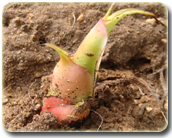 |
Rhizomes
Whole or split rhizomes can also be used when suckers are not available. Bits of rhizome of 2.0 Kg or more may be planted in the nursery for sprouting or directly sown in the main field. for quick multiplication of a variety rhizome bits may be used. Though the plants will require little longer time to fruit. |
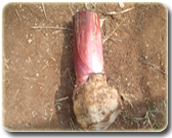 |
Seed
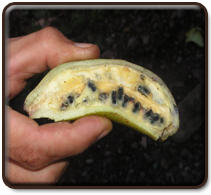 |
 |
-
Seed propagation is common in wild species which are diploid and undergo normal meiosis, fertilization and seed set.
-
The extent of seed set, germinability and dormancy depends on the species.
-
In Ensete, the only other genus of Musaceae, seed propagation is the only means of perpetuation since sucker production is absent.
-
Seeds are generally brown to black in colour, 2-6 cm in diameter, round or triangular in shape, and mostly compressed in appearance.
-
Fruits of wild species are inedible, being full of seeds that are enveloped in thin mucilaginous pulp
-
In India, this propagation system is not followed because all cultivated commercial bananas are parthenocarpic.
Micro-Propagated Plants
Introduction
Micropropogation is the practice of rapidly multiplying stock plant material to produce a large number of progeny plants under aseptic conditions, using modern plant tissue culture methods.
Steps involved in the micro propagation of banana :
-
Selection of pedigree mother plant.
-
.Establishment and maintenance of mother block nursery.
-
Selection of superior planting material for in vitro initiation.
-
.Rouging at various stages of proliferation.
-
Rooting, primary hardening and rouging.
-
Secondary hardening and rouging off-types .
-
Virus indexing and genetic fidelity testing at various stages of micro propagation.
Tissue culture protocols
Selection of superior initial planting material
 |
-
The sucker should be healthy and not less than 60-80 days of age.Growing meristem should be of 1.0 cubic cm in size.
-
Micropropatation of Musa involves establishment of aseptic culture of shoot tips. This is achieved by disinfection,excision and incubation of explants.
-
NaCl is the common disinfectant and the laboratory grade is normally used at concentrations ranging from 0.5-1.0%.
-
If the explant is disinfected after excision a shorter treatment time (5 minutes).Sucrose is the most preferred carbon source used at a concentration of 2-4%(W/V).Vitamins, thiamine, Nicotinic acid and pyridoxine are frequently used.
-
Amino acid glycine is being used as an imediate source of nitrogen cultured tissues.Commonly used reducing agents are ascorbic acid – citric acid (1.0 and 1.5% W/V respectively) which are used in various stages like disinfecting solution itself or after disinfection.Auxins and cytokinons are commonly used for rooting and shooting respectively.
-
The widely used auxins are IAA, NAA and IBA. BAP is the cyotkinin of choice for in vitro shoot bud proliferation.Ph is usually maintained at 5.8, which is prone to changes over culture duration.
-
The optimum incubation temperature should be between 24-26°C.Generally the light intensity maintained ranges from 1,500-3,000 lux.Higher levels of 3,000-10,000 lux during the later stages improve the survival rate of plant lets up on transfer to soil.
Culture initiation
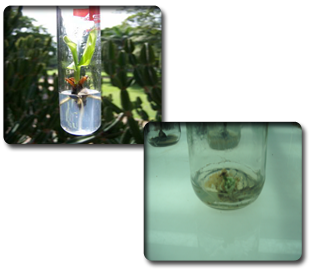 |
-
Shoot cultures of banana start conventionally from any plant part that contains a shoot meristem, i.e. the parental pseudostem, small suckers, peepers and lateral buds.
-
The apex of the inflorescence and axillary flower buds are also suitable explants for tissue culture initiation.
-
Overall, it is important to select explant material from preferably mature individuals.
-
For rapid in vitro multiplication of banana, shoot tips from young suckers of 40-100 cm height are most commonly used as explants.
-
From the selected sucker a cube of tissue of about 1-2 cm³ containing the apical meristem is excised.
-
This block of tissue is dipped in 70% ethanol, surface sterilized in a 2% sodium hypochlorite solution, and after 20 min rinsed three times for 10 min in sterile water.
-
Subsequently a shoot tip of about 3 × 5 mm, consisting of the apical dome covered with several leaf primordia and a thin layer of corm tissue, is aseptically dissected.
-
Larger explants have the merit of consisting of a shoot apex bearing more lateral buds which rapidly develop into shoots.
-
The explant is then further reduced in size (0.5-1 mm length), leaving a meristematic dome with one or two leaf initials.
-
Meristem cultures have the disadvantage that they may have a higher mortality rate and an initial slower growth.
-
The explant is placed directly on a multiplication-inducing culture medium. For banana micropropagation, MS-based media are widely adopted.
-
Generally, they are supplemented with sucrose as a carbon source at a concentration of 30-40 g/l.
-
Banana tissue cultures often suffer from excessive blackening caused by oxidation of polyphenolic compounds released from wounded tissues. These undesirable exudates form a barrier round the tissue, preventing nutrient uptake and hindering growth. Therefore, during the first 4-6 weeks, fresh shoot-tips are transferred to new medium every 1-2 weeks.
-
Alternatively, freshly initiated cultures can be kept in complete darkness for one week.
-
Antioxidants, such as ascorbic acid or citric acid in concentrations ranging from 10-150 mg/l, are added to the growth medium to reduce blackening, or the explants are dipped in antioxidant solution (cysteine 50 mg/l) prior to their transfer to culture medium.
-
Usually two types of growth regulators, a cytokinin and an auxin, are added to the banana growth medium.
-
In most banana micropropagation systems, semi-solid media are used. As a gelling agent agar (5-8 g/l) is frequently added to the culture medium. Liquid media are superior for shoot multiplication, but for maximum plant production and survival ex vitro, one culture cycle on semi-solid medium is also needed.
Culture proliferation
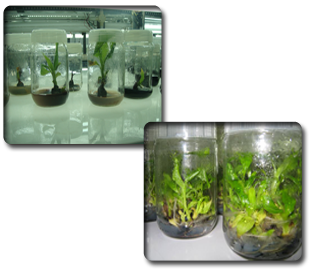 |
-
First subculture is done after 4 weeks of inoculation.By this time, explants enlarge to about double the original size.The blackened surface is scraped off and corm base is reduced to 0.5cm thickness.
-
Reducing the thickness of basal corm tissue decreases blackening,eventually chances of proliferation of non-meristamatic tissue outgrowing the meristamatic tissue.Any growing apical shoots, is cut to activate the axillary buds.By the end of first subculture shoots may be seen with 1-3 side buds. The blackened surface is scraped off, and vertical cuts given in subculture-I are extended till the corm base, so that four quardrants are obtained.By the end of second subculture cycle is repeated at 4 weeks interval to increase the proliferation rate. After 5-6 subculture cycles, the proliferated buds are put in a regeneration medium containing 1/10cycles, the proliferated buds are put in a regeneration medium containing 1/10th BAP.The shoots develops are then rooted in 1/2MS medium with IBA and activated charcoal.After a month, the rooted plants are ready for hardening.
Hardening
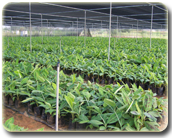 |
-
Micropropagated plants are delicate in nature as they are grown under artificial conditions of High humidity and optimum light intensity.Rooted shoots of 6-10cm tall with well ramified roots are washed free off agar medium and taken to the micropots containing soilrite and then shifted to growth tunnels for further establishment.After an appropriate period of hardening, the plants are taken out of the micorpots roots are dipped in a fungicidal solution to reduce the risk of damage by fungal diseses.Then repotted in a mixture containing 1:1:1:1 of soil:sand:soilrite and FYM.
-
Once after repotting they are shifted under 75% shade nets where they are exposed to 60-70% RH slight intensity of 40-45 mol/m2/sec for about 10-12 days.Next stage , they are maintained at 50-60% RH and light intensity of 200 mol/m2/sec for about 10-15 days and at an intensity of 600 mol/m2/sec for another month.These plantlets are shifted to polybags containing 1:1:1 of sand :soil:FYM and maintained in green house (light intensity of 600-700 mol/m2/sec)until field planting.During primary and secondary hardening plants should be roughed for somaclonal variations. This could be for vegetative deformities,foliar deformities like variegation, rosette foliage others like dwarfism etc.Important points to be taken care during secondary hardening of TC plants are as follows:
-
The rooting media should be 100 per cent free from pathogen.
-
Water used for irrigating the plants should be free from pathogens and nematodes.
-
Strict rouging by trained personnel should be done to remove the types once in 7 days
-
Sample plants from each batch should be randomly virus indexed (atleast 10 plants from each batch/explants).
-
While shifting of primary hardened plants, two longitudinal cuts of net pots should be given to facilitate further corm growth.
Manuring and plant protection in nursery
-
Plantlets should be 2-3 weeks old before any fertilizer application is taken up.100ml water containing 05.kg Urea, 2g Super phosphate and 1g Muriate of potash can be applied per plant.The manuring is repeated by doubling the dosage after three weeks.
-
Spraying of commercially available micronutrient mixtures during sixth week would help in better establishment both in nursery and field.Sanitary measures are strictly adopted in the nursery to avoid the risk of damage by pests and diseases.
-
Pest and diseases encountered during the process of hardening are to be given due attention at appropriate times especially foe soil borne nematodes and aphids which transmit BBTV.The maximum number of subculture cycles should be adhered to 7 or less to check off types to the minimum.
Ideal tissue culture plant
-
A well hardened plant should be minimum of 30 cm in height and should have a pseudostem circumference of 5.0-6.0 cm after 45-60 days of hardening.
-
.The plant should have 5 photosynthetically active leaves and inter foliar space must be not less than 5.0 cm.
-
The plant should have approximately 25-30 active roots at the end of secondary hardening stage.
-
The length of active roots should be more than 15 cm with a good number of secondary roots.
-
The poly bag should be size (20.0cm in length and 16 cm in diameter)with potting media filled to ¾ full of the bag.
-
The media/potting mixture approximately should weight about 750-800g.On dry weight basis.
-
Plantlets should be free from any visual symptoms of leaf spot, pseudostem rot and physical deformations.
-
Plantlets should be free from the presence of root pathogens like Erwinia rot symptoms, nematode lesions and root knots.Random checking of roots is very essential at the time of procurement.
-
Those exhibiting abnormal growth must be discarded.
Management of pest and diseases during secondary hardening
Erwinia head rot or Tip over disease
 |
-
The disease is widespread in banana growing areas of the world.The casual agent is Erwinia carotovora (Jones).This disease is also noticed in the secondary hardening stage of banana tissue culture production.
-
Rotting of collar region is the commonest symptom this disease.The leaves of affected plant show epinasty and dry out suddenly.If the affected plant are pulled out, the plant topple from the collar region leaving the corms with their roots where as plants affected with nematodes cab be pulled out along with corm and roots.This is a distinguishable feature for soft rot disease.
-
In early stage of infection dark brown or yellow, water soaked areas are visible in the cortex area.Drenching of tissue culture plants kept in polybags with 0.1% Emisson or 2% bleaching powder can control the disease.
Parasitic nematodes infestation
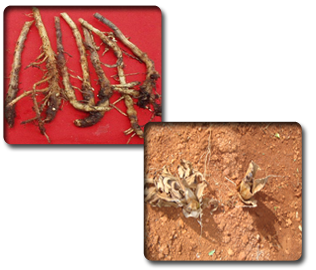 |
-
Banana tissue culture plants are highly susceptible to parasitic nematodes such as root knot nematode (Meloidogyne incognita), lesion nematode (Paratylenchus coffeae), burrowing nematode (Radopholus similes) and spiral nematode (Helicotylenchus multicinctus).These nematodes enter the plant roots through contaminated water or through the pot mixture used for hardening of tissue culture plants.
-
The tender toots of affected tissue culture plant become weak and cannot absorb nutrients as the roots are damaged.In case of root-knot nematodes are predominantly present in the primary and secondary hardening stage of tissue culture plants.
-
In case burrowing or lesion nematode infection, the roots exhibit extensive reddish brown lesions in the cortex can be seen when cut longitudinally.Use water, soil and other pot mixture material free of parasitic nematodes.
-
Fumigated pot mixture can be used for secondary hardening.Application of 2-3gm of carbofuran per plant in the secondary hardening stage can protect against invading nematodes.Appliction of VAM or neem cake also would ensure vigour and health of the plants.
Factors to select off-type production
-
Off-type can arise at any time in culture.
-
They may arise from stimulation of adventitious buds.
-
Growth regulators don’t directly induce mutagenesis (their effect is indirect).
-
Nursery screening procedures are available for rouging off-types.
-
Cavendish types can be identified by morphological characters.
-
Molecular markers can be used.
Tissue culture Unit
Infrastructure
Lab Facilities
-
Washing room.
-
Media preparation room.
-
Inoculation(room).
-
Growth(room)
Hardening Facilities
-
Transfer area.
-
Green house / shade area.
-
Nursery
Quality Control
-
Selection of clones.
-
.Explant.
-
Virus indexing.
-
Number of multiplication cycles.
-
Overall quality of the plants.
Technical Supervision and monitoring
-
Monitoring of the production process and the staff involved there in.
-
Technical competence of the production supervisory staff.
-
Operators.
Merits
-
Rapidity in propagation and abundant availability.
-
Uniformity of micro propagated plants for both genotypic and phenotypic characters.
-
The plants produce higher yield, because the mother plants are selected from high yielding clones, hence the progenies tend to produce heavy and uniform bunches with uniform maturity.
-
The TC plants are healthy in quality because they are free pests and pathogens.
-
Easy to transport for longer distances with cheaper cost than the conventional suckers .
-
Unlike suckers, the tissue culture plants can be produced any time in the year for planting in any agro ecological zones.
Demerits
-
Inability to lower high frequency of off-types in certain cultivars (Somaclonal Variants).
-
Inability to deal with endogenous bacteria or bacteria-like contaminants contributing to significant losses in and immediately after, culture.
Macro-Propagated Plants
Importance of Macro propagation
-
It can rapidly multiply plantlets to distribute a new variety or replace plants in disease-affected fields.
-
It gives relatively healthy plants if source suckers are from healthy mother plants and contamination is minimized during the process.
-
It can be done locally at low cost and with little training: a private person or a farmers’ organization can launch this activity.
-
It can teach awareness of principles of plant health.
Decapitation
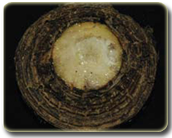 |
-
Macropropagation is an excellent option for producing low cost quality planting material.This is a simple method because of the ease of multiplication, saves cost of producing planting material and has the potential of producing 50-60 shoots per sucker in 4-5 months.
-
Macropropagation is achieved by two methods and could be adopted either in the field conditions (in situ) or in the nursery (ex situ). It involves, decapitation, decortication and hardening.4-6 month old plant is headed back, the pseudostem is cut down and cross cuts/ incisions are made on the growing meristem so as to stimulate the production of lateral buds.This method results in the production of 9-15 uniform shoots per plant in a short span of time and is highly suitable for small and marginal farmers whose requirements of planting material are relatively small.
-
Suckers of choice varieties can be maintained in a nursery either in sawdust bed or in a big, bottomless concrete pot.The initial planting material should preferably be certified as virus free and multiplied at farm level under an insect proof net house.
Decortications
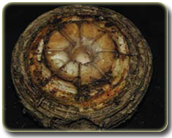 |
The pseudostem of the mother corm or sword sucker is cut transversely 2 cm above the collar region and then the apical meristem is removed leaving a cavity of 2 cm diameter and 4 cm depth.Decapitation and decortication activate the lateral buds giving rise to more side shoots.Generally, the corms that have already flowered give better results than corms that have not yet flowered.Hence, healthy corms left in the field after harvesting are also a potential explant both for in situ and ex situ mass multiplication.
Ex situ mass multiplication
Sword suckers are pared partially (trimmed of all roots and the outer surface scraped) and the growing points are excised out with a sharp knife. These corms are surface sterilized by dipping in 0.3 % bavistin for 15 min, allowed to dry for a day and then planted in the initiation medium, usually comprising rice husk or sawdust, though the latter is much preferred.The initiation medium should essentially provide anchorage, moisture supply and proper aeration to the roots.Before use, the medium is moistened and decomposed for a period of 2-3 weeks to allow dissipation of the build up heat during decomposition.The medium could be enriched with sterilized vermicompost, biofertilizers and rooting hormones like IBA (2,500 ppm). 200 g of VAM/Azospirillum is mixed with 10 kg of vermicompost and 500 g of the foresaid mixture is applied per corm.This treatment induces the production of lateral buds through an enhancement in the population of Pseudomonas and Aspergillus species, while IBA induces rooting in the developing multiple shoots.
Secondary decortications
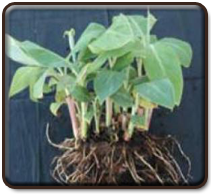 |
After 30-35 days of first decortication, 3-4 buds emerge from the mother corm, depending on the variety.When the side shoots attain a height of 15-20 cm with 3-4 leaves, secondary phase decortication is done by heading back with a sharp knife followed by 3-4 transverse cuts.This encourages production of multiple shoots.Third phase decortication is again attempted after 20-25 days but with greater care as the shoot buds are located very close.Thus by the end of 140-150 days, a total of 50-60 shoots are produced from a single sucker.
Hardening
 |
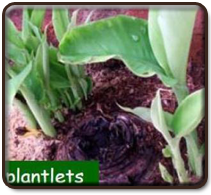 |
 |
|
|
The lateral sprouts of 8-10 cm length are shifted to pro-trays containing equal parts of cocopeat and vermiculite and after sufficient watering left in a shade net (70 % shade) at 80-90 % humidity.High humidity is achieved by intermittent misting.Sprouts are usually maintained in the pro-trays for a period of 15-20 days and then shifted to polythene bags of size 6’x 4’ and thickness of 120 gauge for secondary hardening.At this stage, the plants are maintained at 50 % shade and 40-50 % humidity.Watering is done on alternate days and the plants are ready for field planting in 30-45 days.
In situ mass multiplication
In situ production of suckers is induced chemically by pouring 4 ml of 40 ppm BAP into the decorticated cavity and covering the individual mats with a mixture containing equal parts of sandy loam and poultry manure to 5 cm above the ground level.Such chemical induction of lateral buds could be done on the first generation suckers and continued up to third generation suckers.This method leads to the production of 45-50 shoots in a short span months.The suckers are separated from the mother corm and subsequently rooted in sterile soil medium under intermittent misting.
